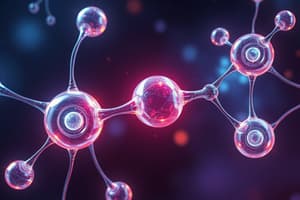Podcast
Questions and Answers
The arrangement of electrons determines the properties and behavior of an atom. Explain the significance of electron arrangement in determining the chemical reactivity of an element.
The arrangement of electrons determines the properties and behavior of an atom. Explain the significance of electron arrangement in determining the chemical reactivity of an element.
The arrangement of electrons determines the chemical reactivity of an element because it determines the element's ability to gain, lose, or share electrons in chemical reactions, which in turn determines its ability to form bonds with other elements.
Describe the relationship between electron arrangement and the physical properties of an element. Provide examples to support your explanation.
Describe the relationship between electron arrangement and the physical properties of an element. Provide examples to support your explanation.
The arrangement of electrons in an element influences its physical properties such as melting point, boiling point, and conductivity. For example, elements with similar electron arrangements often exhibit similar physical properties, such as the noble gases having low boiling points and poor conductivity due to their stable electron configurations.
How does the arrangement of electrons in an atom contribute to the formation of the periodic table? Explain with specific examples.
How does the arrangement of electrons in an atom contribute to the formation of the periodic table? Explain with specific examples.
The arrangement of electrons in an atom contributes to the formation of the periodic table by influencing the atom's chemical properties, which in turn determines its placement in the periodic table. For example, the number of valence electrons in an atom determines its group number in the periodic table.
Flashcards are hidden until you start studying




